 Return to
Return toAviation Answer-Man
Gateway
 Return to
Return to
Aviation Answer-Man
Gateway
 Return to
Return to.
Chapter 6
The
Supermarine Spitfire
and its immediate predecessors
the Supermarine seaplane racers.
Copyright 2000, 2001, 2002 by Richard Harris
All Rights Reserved
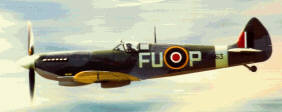
At a glance, you can recognize the lines of World War II's most important fighter aircraft in the rocket-like Supermarine "seaplane" racer (shown below, left)which straddles a pair of pontoon floats. (In the 1930's -- when airports were rare -- the fastest planes landed on water, because there weren't many runways that could provide a surface long enough and smooth enough for the fast, heavy, tiny-winged racers to land safely.) Originally concieved as a racing plane to win the 1930's Schneider Cup trophy for seaplanes, the Supermarine racer was the fastest, time and again, at speeds up to 380 miles per hour.
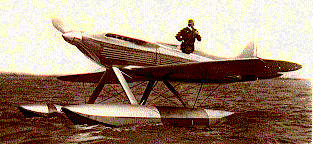 The Supermarine racer's development led directly to the creation of the Spitfire, and -- along the way -- the even more important Rolls-Royce Merlin engine, which would not only power the "Spit", but a third of Britain's warplanes (including the Hurricane fighter, Lancaster heavy bomber and the speedy Mosquito). The Merlin engine would eventually also put the decisive margin of power into the war's best fighter plane -- America's P-51 Mustang.
The Supermarine racer's development led directly to the creation of the Spitfire, and -- along the way -- the even more important Rolls-Royce Merlin engine, which would not only power the "Spit", but a third of Britain's warplanes (including the Hurricane fighter, Lancaster heavy bomber and the speedy Mosquito). The Merlin engine would eventually also put the decisive margin of power into the war's best fighter plane -- America's P-51 Mustang.
If the Mustang was the "best" World War II fighter, why was the Spit the "most important"? Because it was where it was needed, WHEN it was needed. Although America provided some early Mustangs to the British, the Mustang was not ready as soon as it was needed. America had not yet even thorougly armed for the conflict. The Mustang was not yet up-to-snuff when the Germans attacked Britain.
The United States -- clinging to the isolationist priority of "American self-interest" -- was still officially neutral while Hitler conqured the European continent and poised to leap upon Britain, in 1940. Britain was still bascially on her own, facing the mightest military power in history. Armed with thousands of giant tanks, "U-boat" submarines, motorized infantry by the hordes, and led by an air force with thousands of modern fighters and bombers, Nazi Germany had stomped across Europe, subjugating everyone in sight. As they stood on the edge of the English Channel, Hitler ordered the Nazis to prepare to invade Britain, only 30 miles across the water.

The invasion was to begin with weeks or months of aerial bombardment, intended to force Britain to surrender, or to cripple her -- with a crushing German invasion to follow. But, contrary to Hitler's plans, the Battle of Britain would be fought entirely in the air. As German bombers attacked, guarded by speedy, well-armed Messerschmit Me-109 fighters, the British counter-attacked with their fighters. Britain's sturdy, old-fashioned Hawker Hurricane fighters (above, right) were adequate to the task of shooting down the bombers, but simply could not outfight the Germans' fast, modern Me-109 escort fighters.
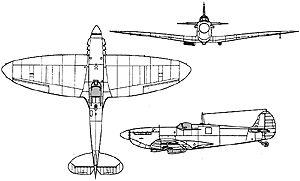 But Britain's Supermarine Spitfire -- with speed equal to the German Me-109, superior rate-of-climb and maneuverability, faster-firing guns, and better pilot visibility and controllability -- was flatly superior to its toughest opponent. The "Spit" had the advantage in a dogfight.
But Britain's Supermarine Spitfire -- with speed equal to the German Me-109, superior rate-of-climb and maneuverability, faster-firing guns, and better pilot visibility and controllability -- was flatly superior to its toughest opponent. The "Spit" had the advantage in a dogfight.
Teamed with the slower (but stout and plentiful) Hurricane fighters, the Spitfire made the German air fleets pay dearly for every raid on Britain. Though the Germans attacked in waves of hundreds, the Spits tied up the Messerschmitts, while the Hurricanes tore up the bombers. The Spitfire cleared away the German escort fighters, and the Hurricanes sent the invading bombers crashing into the sea by the hundreds. When Hitler's Air Marshal, Hermann Goering, asked his top commanding ace -- Adolf Galland -- what the Luftwaffe needed to have to win the Battle of Britain, Galland replied in one word: "Spitfires."
 Though the "Battle of Britain" wore on for months, and the Nazis managed to wreck and torment much of Britain's cities, killing thousands, the cost to Germany's air force (the "Luftwaffe") was intolerable -- whittling away the lion's share of Germany's aircaft and aircrews in a futile attempt to weaken the resistance of the British. The outcome of the world's first major, long-term aerial battle was decided by the Spitfire. After months of shocking, bloody failure, Hitler abandoned his plans to invade Britain.
Though the "Battle of Britain" wore on for months, and the Nazis managed to wreck and torment much of Britain's cities, killing thousands, the cost to Germany's air force (the "Luftwaffe") was intolerable -- whittling away the lion's share of Germany's aircaft and aircrews in a futile attempt to weaken the resistance of the British. The outcome of the world's first major, long-term aerial battle was decided by the Spitfire. After months of shocking, bloody failure, Hitler abandoned his plans to invade Britain.
Britain's own Spitfire had saved her, halted Hitler, and gave the facist German/Italian Axis its first clear defeat -- turning the tide of the war. And the "Spit" would go on to chase German planes from the Western European skies, while British and American bombers turned the air war back on the Germans. With increasing refinements, over the course of the war, the Spit's speed grew by about 100 miles per hour, and its weight by a ton, as its armament grew. By war's end, over 20,000 Spitfires had gone into battle, but none would be more important than the first Spifire Model I's, which defended the British Isles, and altered the course of history.
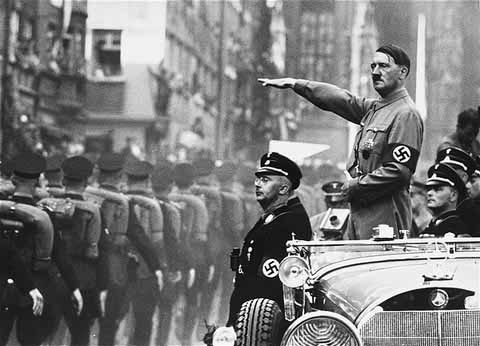 Had the Spitfire not been present at the Battle of Britain, in sufficient numbers, the powerful German Messerschmitt Me-109 fighters might have chopped up the other Britsh fighters (much slower), and cut a path through British defenses -- a path that German bombers could follow to their targets.
Had the Spitfire not been present at the Battle of Britain, in sufficient numbers, the powerful German Messerschmitt Me-109 fighters might have chopped up the other Britsh fighters (much slower), and cut a path through British defenses -- a path that German bombers could follow to their targets.
After pulverizing Britain from the air, Hitler planned to invade. The British might have had to beg for peace with Hitler, on his terms. The result could have been a radically different world for generations. The war in Europe could have ended -- with Hitler the victor -- before America ever got involved.
The Spitfire kept that from happening. That's enough to make the Spitfire one of the most important human inventions of all time.
Why these aircraft stand out from their "peers."
While many other planes have been important, few (if any) others had nearly so pivotal an impact on aviation or on history, as the Supermarine seaplane racers and their evolutionary pinnacle, the Spitfire. These aircraft are "indispensible"aircraft to history -- aircraft with no significant concievable substitute available at their juncture in history.
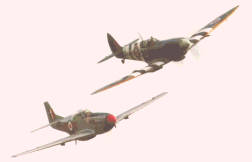 As noted before, only the Spitfire (right, high) was ready to defend the British Isles against the best German fighters. And nothing else caused the development of the spectacular, efficient, powerful Rolls-Royce Merlin engine -- possibly the most important airplane engine of World War II, which would power much of Britain's decisive airpower, and would later enable America's P-51 Mustang (right, low) -- previously underpowered with its original American engine -- to gallop to victory.
As noted before, only the Spitfire (right, high) was ready to defend the British Isles against the best German fighters. And nothing else caused the development of the spectacular, efficient, powerful Rolls-Royce Merlin engine -- possibly the most important airplane engine of World War II, which would power much of Britain's decisive airpower, and would later enable America's P-51 Mustang (right, low) -- previously underpowered with its original American engine -- to gallop to victory.
The Spitfire (an outgrowth of the Supemarine seaplane racers) turned the tide of the Second World War -- the greatest conflict in human history. No other single airplane design in the history of the world can claim to have done such a thing, ever.
 Return to
Return to
 Return to
Return to
Aviation Answer-Man
Gateway